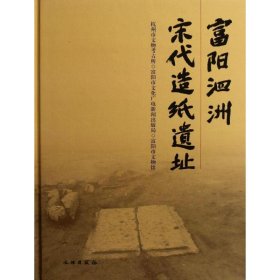
富阳泗州宋代造纸遗址
全新正版 现货速发
¥ 178.3 5.0折 ¥ 360 全新
库存2件
江苏无锡
认证卖家担保交易快速发货售后保障
作者唐俊杰
出版社文物出版社
ISBN9787501033850
出版时间2012-04
装帧精装
开本其他
定价360元
货号1200249549
上书时间2024-10-22
- 在售商品 暂无
- 平均发货时间 9小时
- 好评率 暂无
- 最新上架
商品详情
- 品相描述:全新
- 商品描述
-
目录
章 概述
节 地理环境
第二节 历史沿革
第三节 发现与发掘缘起
第四节 遗址的发掘与性质的认定
第五节 遗址保护
第六节 资料整理与报告编写
第二章 地层堆积
一 T2西壁
二 T8西壁
第三章 遗迹
节 第3层下遗迹
(一)房址
(二)水井
(三)灰坑
(四)墓葬
第二节 第2层下遗迹
一 探方内遗迹
(一)灶
(二)水池
(三)水沟
(四)房址
(五)墙基
(六)道路
(七)陶缸
(八)水井
(九)灰坑
二 探沟内遗迹
第三节 b层下遗迹
(一)道路
(二)灶
(三)陶缸
第四章 出土遗物
节 第3层堆积出土遗物
第二节 第3层下遗迹出土遗物
一 H6出土遗物
二 J3出土遗物
第三节 第2层堆积出土遗物
第四节 第2层下遗迹出土遗物
一 Z7出土遗物
二 C1出土遗物
三 C2出土遗物
四 C3出土遗物
五 C7出土遗物
六 C8出土遗物
七 C9出土遗物
八 G1出土遗物
九 G2出土遗物
十 G4出土遗物
十一 G5出土遗物
十二 G6出土遗物
十三 G8出土遗物
十四 G9出土遗物
十五 02出土遗物
十六 G缸1出土遗物
十七 J1出土遗物
十八 J2出土遗物
十九 H1出土遗物
二十 H7出土遗物
二十一 H9出土遗物
第五节 b层堆积出土遗物
第六节 第lh层下遗迹出土遗物
G缸4出土遗物
第五章 结语
节 遗址年代与性质
一 地层堆积的年代
二 2层下遗迹的年代与性质
三 其他遗迹的年代与性质
第二节 遗址造纸工艺与布局分析
一 文献记载及富阳近现代手工造纸作坊所反映的造纸工艺与作坊布局
二 遗址造纸工艺与布局分析
附表
附表一 遗物统计表
附表二 器物标本统计表
附录
泗洲宋代造纸遗址出土样品的碳、氮稳定同位素分析
后记
英文提要
内容摘要
"A Song Dynasty Paper Mill at Sizhou in Fuyan":The Sizhou paper mill is located to the north of the Fuyang City, in the northern foothill of the Fenghuang Mountain, a tail branch of the Tianmu Mountain. Surrounded by hills on its southern,western, and northern sides, it sits in a valley that opens to the east. The site area, which belongs to Sizhou Village, was once used for growing rice and vegetables, but now laid to waste. In its southern part a small grove of bamboo remains. The site, which is 30° 06' 13" N and 119° 54' 33" E and 17.6m above sea level, is 16 000 square meters in dimension. In September 2008, a joint fieldwork team consisting of Hangzhou Municipal Institute of Cultural Relics and Archaeology and Fuyang Municipal Bureau of Cultural Relics, during the survey procesalong the new route of State Highway 320, discovered the Sizhou site. Since then through March 2009,it carried out a rescue excavation. Altogether 21 excavation pits (T1-T21) and 24 test trenches ( TGI-TG24 ) were exposed. Plus the expanded portions in some areas, the actual exposure amounts to 2 512.5 square meters. The Sizhou site turns out to be a culturally rich one. Below the second layer we discovered a complex of water pools, canals, a large stove, a building foundation, and heat-conducting walls, all of which are linked with each other. Based on these features and subsequent analysis of residue taken from them, textual records and local tradition of paper making, we have come to the conclusion that this was a paper mill of the Song Dynasty. The various types of features and artifacts found here display to us the entire process of paper making. The Sizhou paper mill site faces an ancient riverbed to the south and the Baiyangxi Brook to the north. The ancient riverbed was linked up with one east-west canal and two north-south canals of the site to form a circular water flow. Located in this network, the major features were used for bringing water into the mill, decomposing the fiber, adding lime, boiling and cleansing the fiber, pounding the slurry, making and drying the paper, and draining the waste water. The entire site is thus composed of quarters of suspending, lime-applying and boilding, pounding and making, drying, and draining. Water canals: Two of them, G2 and G9, are linked with the ancient river to the south, and a third canal G8 to the north. They were probably used to bring water from the ancient river to the mill. Decomposing pool: Pool C4 is located in the southeast of the excavation zone. The extant part of it is roughly square, its eastern wall 317cm and southern wall 432cm long, and 28cm deep. Canal G5 to its south functioned as its drainage. Suspending pool: Pool C3, which is located in the south of the site, is trapezoid in shape, 240cm long, 94-132cm wide, and 50em deep. Its walls are finely lined with boulders, although the eastern wall is partially damaged. The floor is flat, formed of yellowish sandy soil. Inside the pool some lime particles are found. Trough G7, which connects to C3, is finally cut out of a slab of 233cm long, 31cm wide and 15cm deep and slanted eastward. Within it some grass ash is found. At the eastern end of this canal is a long trumpet-shaped trough formed of long bricks; the western end of it is blocked with two long bricks of 6cm wide. From the lime particles and grass ash we infer that C3 was a suspending pool filled with limy or limy alkaline solution. Ancient workers placed bamboo materials upon the facility to the west of G7 and poured the solution upon them; the extra solution then flew back to C3. Boiling stove: Stove Z7 is located in the south of the site, elliptical in shape, 540cm long, 455cm wide, and 65cm deep. It is lined with boulders of various sizes, and presently only the bottom is preserved. In the central part, where boulders are neatly laid, a pile of boulders has collapsed into it.The fill contains a lot of burned tiles, charcoal lumps, and grass ash, and when it comes near the bottom,a lot of fired clay, more charcoal lumps, and lime particles. Z7 was therefore the firing chamber below the boiling vat. To increase the volume of the vat, the ancient workers put a bucket upon the vat, filled it with bamboo materials, and sealed the top. The bucket has a holed mat so that it accepts the steam from
相关推荐
— 没有更多了 —




















以下为对购买帮助不大的评价